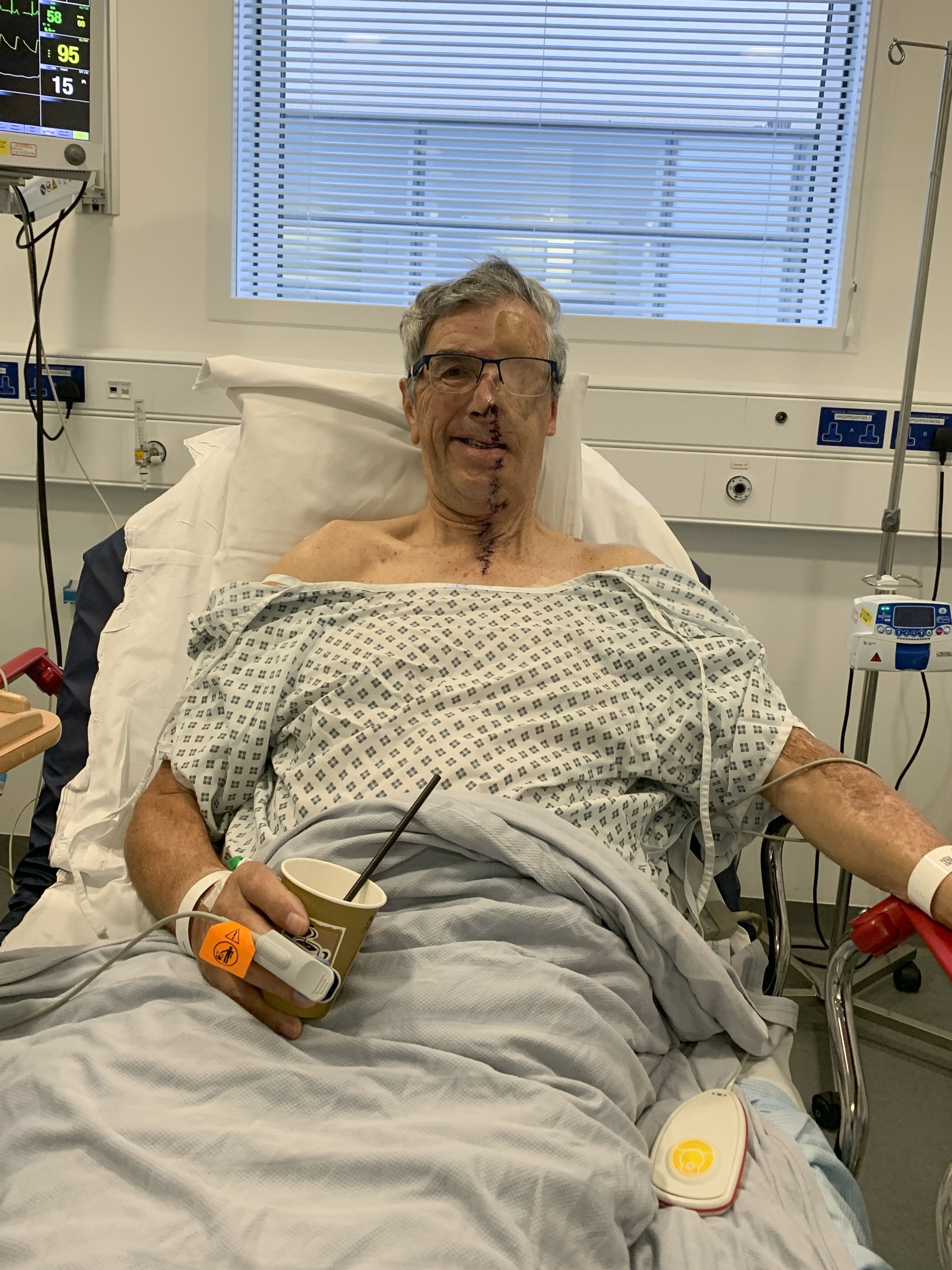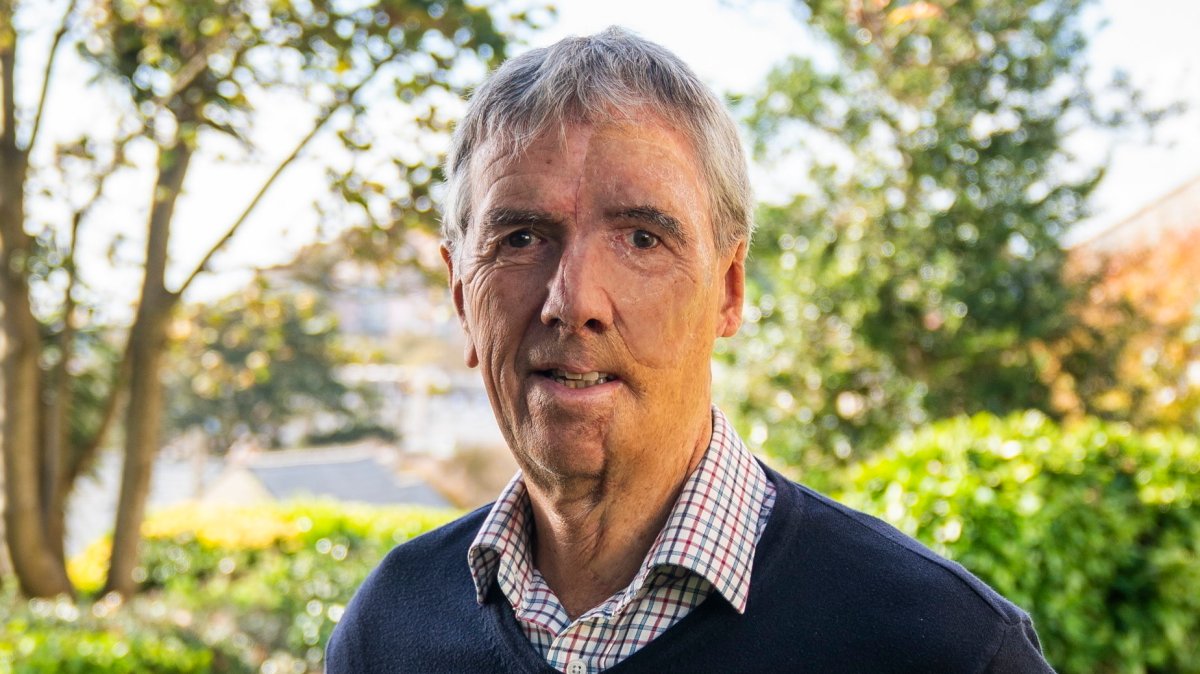When Dave Richards looks in the mirror, he not only counts himself lucky to still be alive, but is also amazed to see his own face looking back at him.
Richards, 75, from Devon, has become one of the first people to have his face rebuilt on the NHS using 3D scanning and printing as part of a process in which specialists crafted a prosthetic cheek, eye and nose that could be affixed each morning and removed at the end of the day.
The prosthesis fits perfectly over the site of a devastating injury, restoring with remarkable accuracy the appearance of a man who has had to live with half a face for more than four years.

Richards before the procedure
TOM WREN/SWNS
He was out cycling with friends in Wiltshire in 2021 when he was smashed off his bike and dragged along beneath the car of a drunk driver. His friends were thrown clear, but the crash broke Richards’s back, pelvis and multiple ribs.
On top of these crush injuries, heat from the car’s exhaust as he was trapped underneath left him with full-thickness burns to the left side of his face and neck.
“It was a lovely sunny day and not long into the ride. We were going up a hill on a B road, and this guy comes up behind us at speed, and over the drunk-drive limit. He was on his phone, racing up behind us and we were all in line,” Richards said.

Richards and his wife before the crash
TOM WREN/SWNS
“He wanted to swerve around us, but there was a car coming the other way, so it was either smash into the car or smash into us. My two friends got hit and were thrown clear of the car, but I got trapped under the car, and was rolled along, with the engine and exhaust burning through one side of my body and the other side being crushed by the car.”
The driver was sentenced to three years in prison but is understood to have been released after 18 months.
Surgeons tried to save Richards’s eye but had to remove it to avoid the spread of infection and he also lost much of his nose. Initial efforts to rebuild the side of his face saw a large “free flap” of skin transplanted from elsewhere on Richards’s body, complete with blood vessels connected to the vessels of his face and neck. It broadly followed the contours of his eye socket and cheek, but left him without a left eye or eyebrow and with a misshapen left nostril.
“In the early days of my recovery, I felt very vulnerable and would not expose myself to social situations,” he said. “It took me a long time to feel comfortable about my image, how I thought people looked at me and what they thought of me, but I have come a long way in that respect. I was keen to explore anything that could be done to alter the visual aspects of my injuries to give me more confidence.”

Richards in hospital after the crash
TOM WREN/SWNS
Richards, who has four grandchildren, was referred to the Bristol 3D Medical Centre at the North Bristol NHS Trust, the first NHS facility where 3D scanning, design and printing have been gathered on one site to produce bespoke medical devices and prostheses.
His face was photographed from several angles in a scanning process that can even capture the shape of someone’s body while they are moving. This created a high-accuracy 3D digital replica of his head.
A mould was then 3D-printed as a guide for specialists to create a wax version of the prosthetic panel. The final version is not 3D-printed but made by specialists from silicone, which was precisely matched to the colour and texture of Richards’s skin down to the inclusion of freckles, veins and wrinkles.
A false eye was made using acrylic and hand-painted to match the colour of the iris and whites of his other eye. False eyebrow hairs were also added.
The prosthesis is fixed to his face with medical-grade adhesive that sticks for nine to 12 hours. Richards has to remove it every night to clean his skin and the back of the panel. It may be possible in future to fix metallic studs into his face that will allow the prosthetic to click into place magnetically.
• Surgeons attach 3D-printed ear built with cells from patient’s own cartilage
“The 3D printers used involve advanced plastic resins whose properties allow direct application to the skin, with materials that are safe against the skin for long periods,” said Amy Davey, a senior reconstructive scientist.
Richards said it was “surreal” and “not the most pleasant of processes”, but said: “I’m glad I’ve followed this treatment process as it has got me to where I am today. I have always said no matter what treatment is offered, if I think there’s a benefit and the risks aren’t too high, I will try anything and have a go and that’s still the case.”

